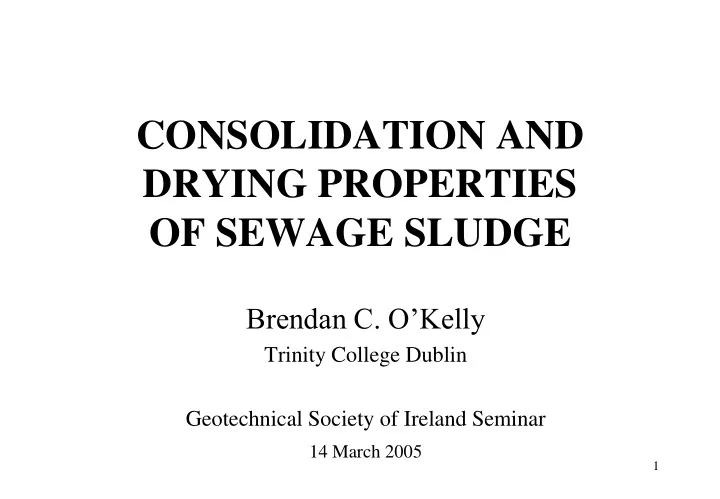

CONSOLIDATION AND DRYING PROPERTIES OF SEWAGE SLUDGE Brendan C. O’Kelly Trinity College Dublin Geotechnical Society of Ireland Seminar 14 March 2005 1
OVERVIEW: • Physical properties of sewage sludge – effects of level of biodegradation • Air-drying and material density • Compressibility and consolidation properties – liquid slurry and dried compacted sludge material – biologically active and stabilised material 2
QUANTIFYING AMOUNT OF PORE WATER Geotechnical literature**: Water content w , mass of pore water to mass of dry solid particles, as % Water treatment literature: Solids content SC , mass of dry solid particles to bulk sludge mass, as % 3
100 (as %) SC w 1 100 • TEST MATERIAL – Tullamore municipal wastewater treatment plant – Anaerobic, activated sludge digestion method – Treated material dewatered to w 720 % using belt filter press 4
PHYSICAL PROPERTIES • Typical properties of Liquid limit 315 % Plastic limit 55 % slurry direct from Shinkage limit 10 % wastewater plant Plasticity index 260 % Specific gravity of solids 1.55 Ignition loss 70 % • Properties indicate Water content 720 % sludge material was Void ratio 11 10.2 kN/m 3 moderately degraded Bulk unit weight 1.3 kN/m 3 Dry unit weigth pH 8.0 5
PREPARATION OF MORE STRONGLY DEGRADED MATERIAL i) Further biodegradation of slurry in laboratory at 35 o C Trapped biogas Graduated Acrylic cylinder, 25 l capacity Drying oven Hydraulic consolidation cell Overflow container Sludge specimen 6
STABILIZATION (optional): slurry pasteurized by heating at 80 o C for 3 hours ii) Sludge also stored outdoors in drums and allowed degrade naturally over ten-year period 7
PHYSICAL PROPERTIES AND STATE OF BIODEGRADATION Ignition loss (A) Slurry direct from wastewater plant, 1.9 – (% dry mass) and after (B) three, (C) four and (D) 30 – indirect measure of months, and (E) ten years. Specific gravity of solids (F) Slurry degraded in the lab at 35 o C 1.8 E organic content F – assess state of 1.7 degradation D C 1.6 B A 1.5 45 50 55 60 65 70 75 Ignition loss (%) 8
AIR-DRYING AND DENSITY • Sludge material dried slowly outdoors Bulk density, Dry density, (tonne/m 3 ) 1.6 0 % air voids curve 1.2 Bulk density 0.8 0.4 Dry density 0.0 0 200 400 600 9 Water content, (%)
COMPRESSIBILITY AND CONSOLIDATION PROPERTIES • TEST APPARATUS: i) Oedometer consolidation cell Porous platen Loading cap Confining Test specimen ring Porous stone • Test specimen dimensions: – 76mm dia. x 19mm high, to 100mm dia. x 40mm high – Consolidation pressures increasing from 3 kPa for slurry, up to 400 kPa for dried compacted sludge material 10
ii) Hydraulic consolidation cell Specimen • Test specimen dimensions: 250mm diameter x 50mm high Effective confining pressures of 100 to 300 kPa 11
CONVENTIONAL ONE-DIMENSIONAL CONSOLIDATION CURVE Initial compression Specimen compression Primary consolidation Secondary compression Logarithm time, (minutes) 12
TEST RESULTS Moderately degraded sludge material: • biologically active i) Slurry direct from treatment plant (w 720 %) Time, (minutes) 1 10 100 1000 10000 0 Vertical stress Cumulative strain, (%) (kPa) 20 3 6 12 40 25 50 60 100 50 13 12 80 3
Dried, standard Proctor compacted sludge material ii) Wet of optimum water content, w 130% Time, (minutes) 1 10 100 1000 10000 0 Vertical stress 5 Cumulative strain, (%) (kPa) 25 10 50 100 15 200 400 20 200 100 25 50 14 30 25
iii) Compacted at optimum water content, w 100% Time, (minutes) 1 10 100 1,000 10,000 Vertical 0 stress 2 (kPa) Cumulative strain, (%) 25 4 50 6 100 200 8 400 10 200 100 12 50 14 37 15
Comparison: Moderately and strongly degraded sludge material, biologically stabilised iv) Slurry direct from treatment plant (w 720 %) Time, (minutes) 1 10 100 1,000 10,000 100,000 0 0 Degree of consolidation, (%) 20 25 Axial strain, (%) 40 50 60 75 s c = 100 kPa, Strain ( 70 % ignition loss) s c = 300 kPa, 80 100 Strain ( 55 % ignition loss) 16 Dissipation excess p.w.p. (55 % ignition loss)
SUMMARY OF COMPRESSIBILITY DATA Void ratio, volume of void space to volume of solid particles 12 Liquid sludge C c = Compression index C s = Swell index 10 8 Void Ratio C c 6 4 C s 2 Optimum sludge compaction 0 1 10 100 1000 Effective Stress, (kN/m 2 ) Calculate amount of consolidation settlement in sludge monofill 17
CONSOLIDATION • Primary consolidation: – compression associated with dissipation of excess porewater pressure • Secondary compression: – indefinite creep, and in case of sludge, significant contribution due to ongoing degradation • Primary consolidation occurred fairly rapidly but constituted only minor part of overall strain response 18
• coefficient of permeability k, for moderately degraded slurry of the order of 10 -9 m/s – greater permeability for higher states of biodegradation – but permeability decreases significantly with increasing applied stress • Secondary compression by far dominant mechanism causing settlement 19
SUMMARY • Physical and mechanical properties affected by level of degradation – Specific gravity, density and permeability increase with increasing level of biodegradation – Strongly biodegraded, stabilised sludge material consolidates more readily – bioegradation continues many years after treatment at waterwater plant 20
• Sludge material dried slowly outdoors • Sludge material practically impermeable, k<10 -9 m/s • Settlement of landfilled material occurs very slowly, and occurs mainly due to creep and ongoing biodegradation 21
THANK YOU 22
Recommend
More recommend